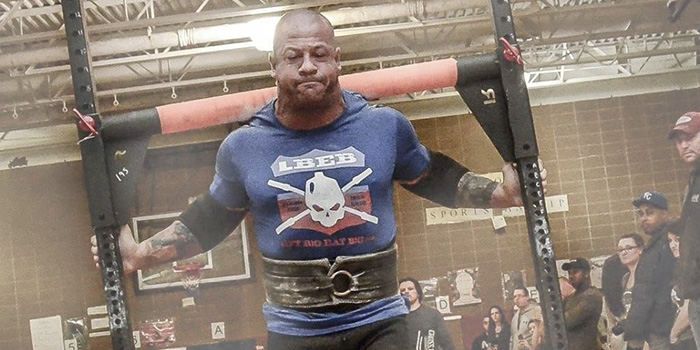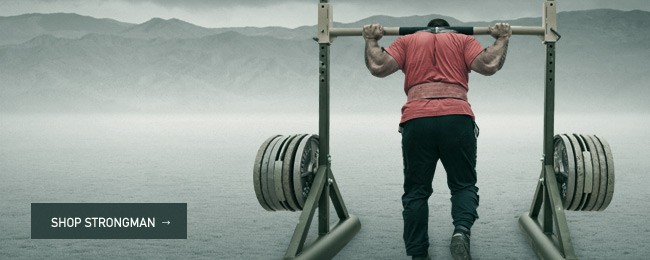
The yoke has been a staple of strongman for years, and with good reason. It is one of the ultimate tests of true grit and determination. I always tell people when teaching the yoke that every muscle has to work when walking with a heavy yoke. This makes the yoke ideal for both building muscle and losing fat. When I began strongman, I was terrible at the yoke, even though it was in almost every competition I had competed in. With it being so common, I had no choice but to improve. I attribute strongman training to adding both 10 pound of mass to my body and simultaneously making me leaner. Putting on muscle while getting leaner, as most of you know, is an extremely difficult thing to do, especially the more advanced you are.
WATCH: Table Talk with Dan Green — The SS Yoke Bar for Squats and Good Mornings
Like most compound movements, the set up is crucial to moving a heavy weight quickly. Check out how I teach the yoke in the video below.
Important tips to remember on the yoke:
- Much like the squat, get extremely tight before you stand up with the yoke. Lats and core should be braced HARD. Squeeze your traps up to create a better shelf for the yoke to sit on.
- Your breathing matters. Take a huge breath in before the start. You want to hold it for as long as you can, and possibly the entire run. If you have issues blacking out while yoking, breathe out just a little, then immediately take as much air in as you can. Do not breathe out all of your air! If you are under a heavy weight you will certainly lose your tightness and drop the yoke. Much like benching, this will take practice holding your breath. I mention benching because most top benchers will hold their breath for multiple reps without breathing in again. Practice holding your breath on your warm-ups to improve.
- If possible, grab the sides of the yoke as seen in the video. Some yokes are very wide, and you may not have a choice but to grab the crossbar. Grabbing the sides gives you more control over the yoke while moving, and prevents it from swaying.
- Your stance should be around shoulder to hip width. If you start in a wider stance this will slow you down, as you won’t be walking wider. It can also make the yoke swing more when you bring your feet in to move. A quick tip to get you moving faster on the pick is to start in a staggered stance. This will only work when the yoke is light enough and you know you are going to fly with it. Again, practice this technique with the weight you will have in the upcoming contest. This technique can also be applied to farmers walks.
- Speed is usually the name of the game when it comes to a yoke. It's rare that you a see a max yoke in a contest, so you want the feet moving fast. As I demonstrated in the video, do not take long strides. Use short, choppy steps and pick up speed as you go. Think about heel-to-toe as you move!
- When moving with the yoke, you want to push the uprights forward like a bench press. This will ensure movement forward as well as keep your back tight, and help you not lose that tightness.
- Follow through! This goes for every moving event. Always go past the finish line. I’ve seen competitors stop short and have to re-pick, losing valuable time.
Accessory Work for the Yoke
I personally like to place the yoke on the day I also squat, as they are the most similar for compound movements. Squatting is a must in any program, so I prefer both back squat and front squat be used — preferably squats with the SS Yoke Bar to strengthen the core and upper back more. Single-leg training is extremely important, as at times you are on only one leg at a time moving the yoke. I find single-leg work largely avoided but crucial for balance not only with the yoke but also for balance of strength on each side of the body, which can prevent injuries. My favorite single-leg exercise is the Bulgarian or rear foot elevated split squat.
Most big yokes also require very big quads. Make sure you train them hard with front squats, as already listed, but I love to also add the leg press to build them. Use more of a narrow stance with your feet slightly lower to really hit your quads hard. Abs are also greatly used on a yoke; when breathing properly you need to brace and push out against the belt as you move. The ab wheel is the best option here, in my opinion.
Sample Yoke Training Session
An example of how I would like to set up a yoke training session would look like this:
1. Yoke — 2 x 50 feet, RPE 8; I would recommend rotating from heavy to light speed runs on the yoke. Going heavy each week is a sure way to get burned out. Time your runs to see improvement!
2. SS Yoke Bar Squats — 3 x 8, 70%
3a. Pause Front Squats — 3 x 3, 65%; pause 2 seconds and explode up
3b. Leg Press — Work up doing sets of 20 for 3 workings sets, with the last set being the heaviest
4a. Bulgarian Squat — 3 x 10; hold dumbbells at sides
4b. Ab Wheel — 3 x 12
I hope these tips improve your yoke time, and if you have anything to add please drop it in the comments.











1 Comment